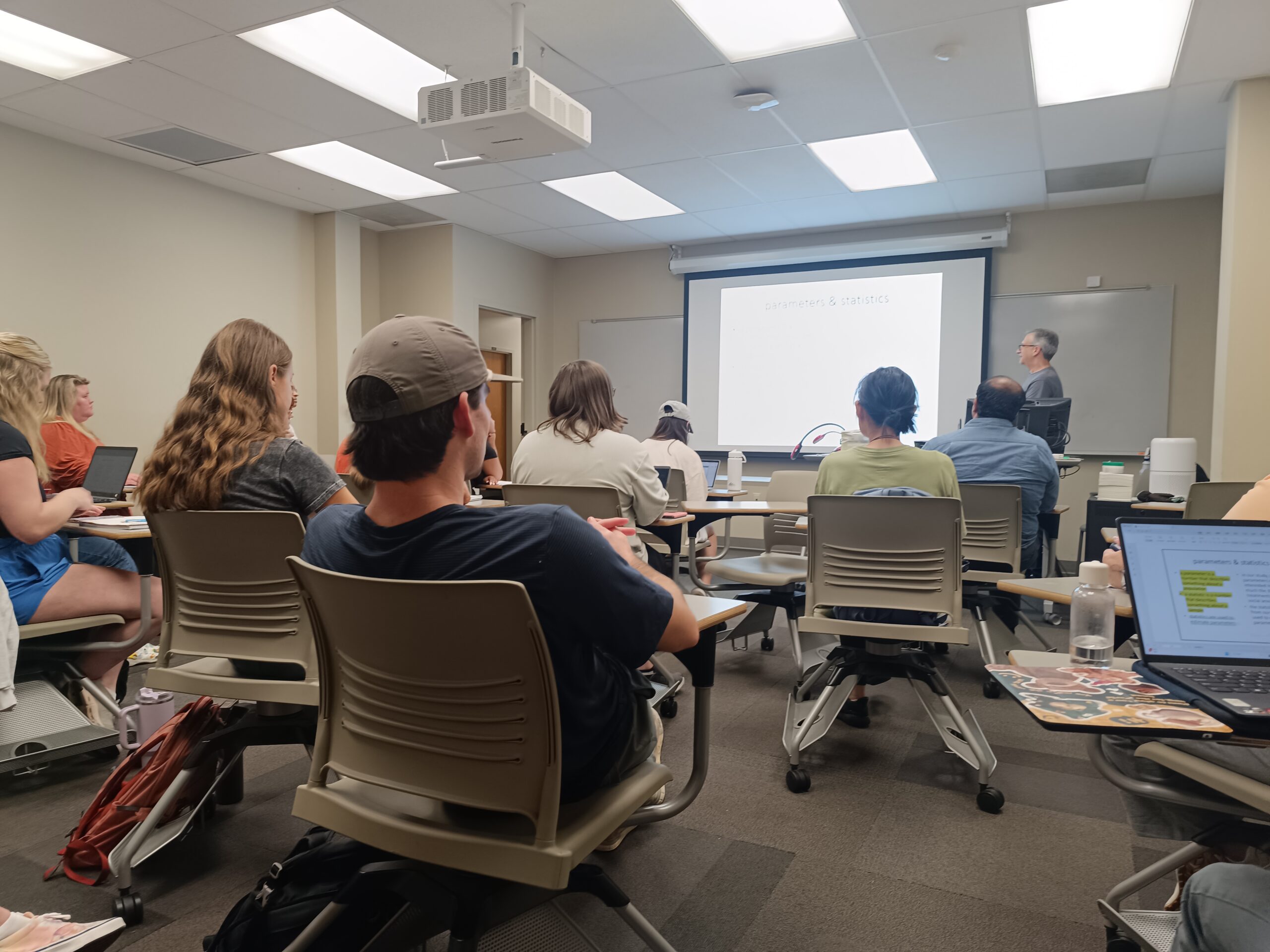Statistical modeling is a way to understand and predict real-world situations using numbers and math. Let me explain it in simple terms:
- Collecting Data:
Imagine you’re curious about something, like how tall people are in your town. You’d measure the height of many different people.
- Finding Patterns:
You look at all these heights and try to find patterns. Maybe most people are between 5’4″ and 6’2″.
- Making a Model:
Based on these patterns, you create a “model” – a simplified version of reality. For height, it might be an average and a range.
- Using the Model:
Now, if someone asks “How tall is a random person in your town?”, you can use your model to make an educated guess.
- Testing and Improving:
You keep checking if your model’s predictions match reality. If they don’t, you adjust your model.
- Dealing with Uncertainty:
This is where variance comes in. It helps you understand how often and by how much your model might be wrong.
Statistical modeling is used in many areas:
- Weather forecasting
- Predicting election results
- Figuring out which medical treatments work best
- Estimating how many products a store should stock
It’s all about using math to make sense of the world and make better predictions about what might happen in the future.
Examples of some models we can explore
1. Ice Cream Sales Model:
This model tries to predict daily ice cream sales based on temperature.
- Data collection: You’d record daily temperatures and ice cream sales for a year.
- Pattern finding: You might notice that sales increase as temperature rises.
- Model creation: You could create a simple equation, like “Expected Sales = 10 + (2 × Temperature in °F)”
- Usage: On a 75°F day, you’d predict selling about 160 ice creams (10 + 2 × 75 = 160)
- Uncertainty: Some hot days might have lower sales due to factors like rain, which introduces variance.
2. Plant Growth Model:
This predicts plant height based on water, sunlight, and time.
- Data collection: Measure plant height weekly, along with water and sunlight levels.
- Pattern finding: You might see that more water and sunlight generally lead to taller plants.
- Model creation: You could use an equation like “Height = 2 inches + (0.5 × Weeks) + (0.1 × Water ml) + (0.2 × Sunlight hours)”
- Usage: After 4 weeks with 100ml water daily and 6 hours sunlight, you’d predict a height of about 8 inches.
- Uncertainty: Some plants might grow faster or slower due to genetics or other factors.
3. Exam Score Prediction Model:
This estimates final exam scores based on study time, attendance, and previous test scores.
- Data collection: Record these factors for many students over several classes.
- Pattern finding: You might notice that more study time and better attendance correlate with higher scores.
- Model creation: You could use a weighted average, like “Predicted Score = (0.3 × Average Previous Scores) + (0.4 × Study Hours) + (0.3 × Attendance Percentage)”
- Usage: A student with 80% previous average, 20 study hours, and 90% attendance might be predicted to score 82%.
- Uncertainty: Individual student performance can vary due to factors like test anxiety or question familiarity.
4. Movie Box Office Model:
This predicts opening weekend revenue for new movies.
- Data collection: Gather data on past movies’ budgets, genres, star power, release dates, marketing spend, and revenues.
- Pattern finding: You might notice that bigger budgets and more marketing usually lead to higher revenues.
- Model creation: You could use a complex equation considering all factors, possibly giving more weight to marketing spend and star power.
- Usage: For a new action movie with a big star and $100 million marketing budget, you might predict $150 million opening weekend.
- Uncertainty: Unexpected factors like competing events or sudden changes in public interest can affect actual results.
5. Grocery Store Checkout Model:
This estimates customer wait times in checkout lines.
- Data collection: Record wait times along with number of open lanes, time of day, day of week, and items per customer.
- Pattern finding: You might see that wait times increase with fewer open lanes and more items per customer.
- Model creation: You could use an equation like “Wait Time = (Customers in Line × Average Items) ÷ (Number of Open Lanes × Items Processed per Minute)”
- Usage: With 10 customers, averaging 20 items each, and 2 open lanes processing 2 items/minute, you’d predict a 50-minute wait for the last person in line.
- Uncertainty: Unexpected events like payment issues or price checks can introduce variance in actual wait times.
Each of these models simplifies complex real-world situations to make predictions. They’re useful, but it’s important to remember they’re approximations and actual results may vary.
.
Lets work with our Ice Cream Sales Model:
- This model tries to predict daily ice cream sales based on temperature.
- Data collection: You’d record daily temperatures and ice cream sales for a year.
- Pattern finding: You might notice that sales increase as temperature rises.
- Model creation: You could create a simple equation, like “Expected Sales = 10 + (2 × Temperature in °F)”
- Usage: On a 75°F day, you’d predict selling about 160 ice creams (10 + 2 × 75 = 160)
- Uncertainty: Some hot days might have lower sales due to factors like rain, which introduces variance.
Let’s break down the math shown in the image:
MSE (Mean Squared Error) formula:
MSE = SSE / (n – p)
- MSE: Mean Squared Error
- SSE: Sum of Squared Errors
- n: Number of observations
- p: Number of parameters in the model
This formula calculates the average squared difference between predicted and actual values, adjusted for the model’s complexity.
Variance formula for a one-parameter model:
MSE = SSE / (n – 1) = Σ(Yi – Ȳ)² / (n – 1)
- Yi: Individual observed values
- Ȳ: Mean of all observed values
- Σ: Sum of all terms
This formula calculates the average squared deviation of each observation from the mean.
In simpler terms:
- The first formula (MSE) is asking: “On average, how far off are our predictions?”
- The second formula (variance) is asking: “How spread out are our data points from their average?”
These formulas help us understand how accurate our model is (MSE) and how much our data varies (variance). In a simple model using just the mean to make predictions, these two concepts become equivalent – the spread of our data (variance) directly relates to how far off our predictions might be (MSE).
Let’s apply these formulas to our ice cream sales model as an example. We’ll compare the general MSE formula with the variance formula for a simple one-parameter model.
Let’s say we have the following data for ice cream sales over 5 days:
- Day 1: 80 sales
- Day 2: 95 sales
- Day 3: 85 sales
- Day 4: 100 sales
- Day 5: 90 sales
Let’s break down the Sum of Squared Errors (SSE) calculation step by step using this example:
SSE stands for Sum of Squared Errors. It’s a measure of how much our predictions (in this case, the mean) differ from the actual values.
- We start with our data points: 80, 95, 85, 100, 90
- Our prediction (the mean) is 90 for each day
Now, let’s go through each day:
1. Day 1: (80 – 90)² = (-10)² = 100
The actual value was 80, our prediction was 90. The difference is -10, and we square it.
2. Day 2: (95 – 90)² = (5)² = 25
Actual was 95, prediction 90. Difference is 5, squared.
3. Day 3: (85 – 90)² = (-5)² = 25
Actual 85, prediction 90. Difference -5, squared.
4. Day 4: (100 – 90)² = (10)² = 100
Actual 100, prediction 90. Difference 10, squared.
5. Day 5: (90 – 90)² = (0)² = 0
Actual matches prediction, so no error.
We square the differences for two reasons:
1. To make all values positive (so negative and positive errors don’t cancel out)
2. To give more weight to larger errors
Finally, we sum all these squared errors:
SSE: 100 + 25 + 25 + 100 + 0 = 250
This total (250) is our SSE. It represents the total squared deviation of our data from our prediction (the mean). A lower SSE indicates that our prediction is closer to the actual values overall.
1. General MSE formula: MSE (Mean Squared Error):
- This is the average of all the squared differences between our predictions and the actual values.
- It tells us, on average, how far off our predictions are.
MSE = SSE / (n – p)
- Where n = 5 (number of observations) and p = 1 (we’re using one parameter, the mean)
MSE = 250 / (5 – 1) = 250 / 4 = 62.5
2. Variance formula: MSE = SSE / (n – 1) = Σ(Yi – Ȳ)² / (n – 1)
MSE = 250 / (5 – 1) = 250 / 4 = 62.5
As you can see, in this simple one-parameter model, both formulas give the same result. This value (62.5) represents both the variance of our data and the Mean Squared Error of our model.
Imagine you’re running an ice cream stand. You know that on average, you sell about 90 ice creams per day. But of course, it’s not exactly 90 every single day.
- When we say “the data points typically deviate from the mean by about 7.9 sales”, it means:
- On most days, your actual sales are somewhere around 7.9 ice creams above or below that average of 90.
- So, on a typical day, you might sell anywhere between about 82 ice creams (that’s 90 – 7.9) and 98 ice creams (that’s 90 + 7.9).
- Some days might be closer to the average, some might be further away, but this gives you a general idea of how much your sales usually vary.
- It’s like saying, “Usually, we’re off by about 8 ice creams from our average, give or take.”
This number (7.9) helps you understand how predictable your sales are. If it were a smaller number, your sales would be more consistent day-to-day. If it were larger, your sales would be more unpredictable.
Understanding this helps you plan better – like how much ice cream to stock or how many staff to schedule on a given day.
A one-parameter model is the simplest type of statistical model. Let’s break this down:
- Definition: A one-parameter model uses only one value to make predictions about a dataset.
- In our example: The single parameter we’re using is the mean (average) of our ice cream sales.
- Why it’s “one parameter”:
- We’re using just one number (the mean, 90 in our case) to represent all our data.
- We’re not considering any other factors that might affect ice cream sales.
- Contrast with multi-parameter models:
- A two-parameter model might use both the mean and the day of the week.
- A more complex model could include temperature, day of the week, and season as parameters.
The t-test process and what it means for our ice cream sales example:
1. Purpose of the test:
We’re trying to determine if the actual average daily sales (90) are significantly different from what the owner expected (85).
2. Sample data:
We have 5 days of sales data, with an average of 90 ice creams per day.
3. Null hypothesis:
We assume the true average sales are 85 per day (the owner’s expectation).
4. Alternative hypothesis:
The true average sales are not 85 per day.
5. T-statistic (1.42):
This number tells us how many standard errors our sample mean (90) is from the hypothesized mean (85).
6. Critical value (2.776):
This is the threshold for statistical significance. If our t-statistic exceeded this value (positive or negative), we’d conclude the difference is significant.
7. Result interpretation:
- Our t-statistic (1.42) is smaller than the critical value (2.776).
- This means the difference between observed (90) and expected (85) sales could reasonably occur by chance, given our small sample size and the variability in the data.
- We don’t have enough evidence to say the true average sales are different from 85.
8. Practical meaning:
- While the sample average (90) is higher than expected (85), this difference isn’t statistically significant.
- The owner shouldn’t conclude that sales are truly higher than expected based on just these 5 days of data.
- More data might be needed to detect a real difference if one exists.
This test helps the owner avoid overreacting to short-term fluctuations in sales, while still providing a framework for assessing when observed differences become meaningful.
Here’s our data again:
- Day 1: 80 sales
- Day 2: 95 sales
- Day 3: 85 sales
- Day 4: 100 sales
- Day 5: 90 sales
Step 1: Calculate the sample mean (Ȳ) Ȳ = (80 + 95 + 85 + 100 + 90) / 5 = 90
Step 2: Calculate the sample standard deviation (s) We calculated this earlier: s ≈ 7.9
Step 3: Calculate the standard error of the mean (sȲ) sȲ = s / √n = 7.9 / √5 ≈ 3.53
Let’s break down where we got sȲ ≈ 3.53:
1. The formula for standard error of the mean (sȲ) is:
sȲ = s / √n
Where:
s = sample standard deviation
n = sample size
2. We know:
n = 5 (we have 5 days of data)
3. For s (sample standard deviation):
We calculated this earlier as the square root of MSE (Mean Squared Error)
s ≈ 7.9
4. Now, let’s calculate sȲ:
sȲ = 7.9 / √5
= 7.9 / 2.236
≈ 3.53
This is how we arrived at sȲ ≈ 3.53.
Null hypothesis (H₀): μ = 85 (expected sales) Alternative hypothesis (H₁): μ ≠ 85 (sales are different from expected)
Step 5: Calculate the t-statistic t = (Ȳ – μH₀) / sȲ t = (90 – 85) / 3.53 ≈ 1.42










Leave a Reply